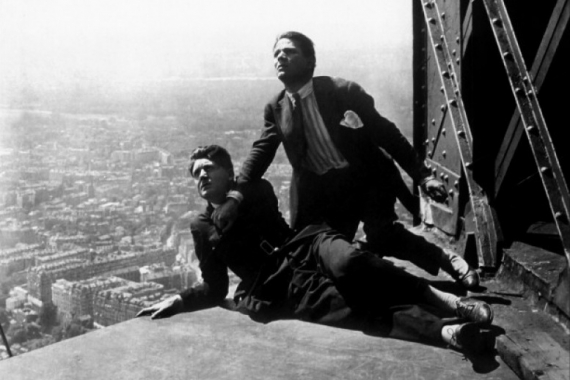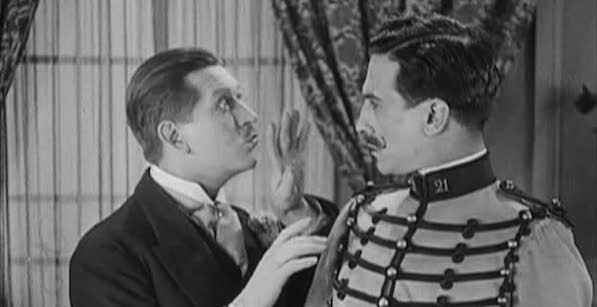A triumvirate of early sound comedies—Under the Roofs of Paris (1930), Le Million (1931), and À Nous la Liberté (1931)—made René Clair‘s reputation as France’s master of modern screen comedy. They explored the possibilities of the new audio dimension as an expressive element without sacrificing the fluid style and creative imagery of the height of the silent era. To American audiences, it was like Clair burst forth upon the international scene fully formed. But that’s because his final silent film—and his first comic masterpiece—The Italian Straw Hat (1927) did not arrive stateside until much later, and then in a version cut by an entire reel.
Filmmaking was not Clair’s original ambition. He intended a literary career and didn’t consider film a serious undertaking. When he took bit parts in a few films as a lark (including a couple of late serials by the great Louis Feuillade), he changed his name to separate it from his journalism and writing, from Chomette (his given name) to Clair (“light”). But he got bitten by the film bug and started rubbing elbows with the artists of the avant-garde, which led to an invitation to direct a short film to play between the two acts of a Dadaist ballet by Francis Picabia. Entr’acte (1924) is filled with cinematic tricks and playful imagery and it features appearances by Man Ray, Marcel Duchamp, and Georges Auric and a score by Erik Satie. Those are impressive credentials and Entr’acte is a landmark of avant-garde cinema of the twenties but apart from a brief revisit to non-narrative filmmaking in La Tour (1928), his love letter to the Eiffel Tower, it’s not where Clair’s heart lay. For that, look to his directorial debut Paris qui dort (1923), a comic fantasy set in a Paris that has been frozen in time by a science fiction ray gun (a prototype for Dr. Horrible’s freeze ray?). Paris qui dort was far more indicative of his interests and ambition and it offered the first glimpse of the talents he would hone over the next few years: a sense of humor tipping to the whimsical, an affection for special effects, a playful approach to storytelling and a warm affection for his characters. Clair loved the great “primitives” of French cinema, the impressionist cinematic sketches of the Lumière Bros. and the fantasy imagery and cinematic trickery of Méliès and Ferdinand Zecca, and above all he revered Chaplin.

All of this came together in The Italian Straw Hat (1927), which he made for the Montreuil-based Albatross studio and producer Alexandre Kamenka, who was turning to young French filmmakers like Marcel L’Herbier (The Late Mathias Pascal) and Jacques Feyder (Gribiche, The New Gentlemen). Albatross secured the rights to the popular 19th-century stage farce and Clair updated it from 1850 to “la Belle Epoque” of 1895 Paris (which is also, as critics have noted, the birth of cinema) and delivered the criss-crossing characters of a screwball comedy with the continental attitude and sparkling wit of a Lubitsch film.
The dapper Albert Préjean is Fadinard, a jaunty bachelor aristocrat whose journey to his own wedding hits a complication when his horse wanders away on a country road and chews on a lady’s hat resting on a tree branch. Up from the bushes pops the very Prussian-looking officer (Geymond Vital) followed by a woman (Olga Tschechowa), whose hair and dress are just disheveled enough to tell us exactly what they’ve been up to. The timing is perfect and the performances priceless as the officer straightens his uniform and fixes a fierce gaze on the hapless groom and the woman attempts to look nonchalant. They may have been caught in flagrante, but any shame or guilt is channeled into outrage at Fadinard’s interruption and an ultimatum is given: replace the hat to protect the woman’s honor (she is married, and not to this officer, as a quick survey of ring fingers confirms) by the end of the day or he will dismantle Fadinard’s home one piece of furniture at a time. Thus Fadinard must sneak out of his own wedding in search of what turns out to be a rare woman’s straw chapeau while keeping the entire episode a secret from his bride (Marise Maia) and father-in-law (Yvonneck), a jolly fellow who manages to drag the entire wedding party into the middle of the mad scramble.
Clair turns a story precipitated by simple plot mechanisms into a lively character comedy and, for all the complications, gets by with under forty intertitles and conveys the rest visually, all while evoking the tableaux compositions and set designs of early cinema. He embraces the conventions without making fun of them and adds a modern sensibility and a witty sophistication. Fadinard’s nightmare visions of the officer destroying his home become an animated fantasy of the furniture fleeing under its own power, and as he recounts the complicated story of horse, hat, and cheating lovers, it becomes a Victorian stage melodrama played out in exaggerated poses against a painted backdrop. The storyteller has reimagined it as his own personal tragedy, with him as the tormented hero. And along with the compounding narrative complications during the hunt for the hat, Clair keeps up running gags with other vestments and accessories—a white glove that never finds it’s match, a pair of painfully tight shoes, a tie that won’t stay put, an ear horn so plugged up the deaf man can only smile and nod—that recur through the film in variations on the theme.
You might expect such madcap complications to come at breakneck speed, like a Keystone Kops free-for-all, but Clair is more measured in his direction of action. It’s not so much a matter of speed as momentum and timing, with Clair meshing the colliding characters and conflicting goals with a clockwork precision that makes it look easy. He takes time to let the personalities fill out each scene and define the humor, from the increasingly anxious Fadinard and the slow-burn officer who faces every frustration by grabbing another piece of furniture to a deaf uncle who is oblivious to everything around him but fakes it anyway. The performances too are more underplayed than we’re used to in silent farce, where personalities are played big. The actors are almost naturalistic, slowly building in desperation and exasperation, with characterizations more wily that wild.
That wasn’t necessarily apparent to American audiences of the day. While it was a critical smash in Europe and launched him into the sound era with the trio of films that made his fame, it didn’t arrive stateside until 1931, after the surprise stateside successes of Under the Roofs of Paris (1930) and Le Million (1931). Released in a version cut by an entire reel, at a time when sound films had complete displaced the silents in American theaters (and thus likely shown at the sound-era standard 24 frames-per-second), the film was dismissed as old-fashioned. In fact, Clair’s original cut was only recently restored for American audiences by David Shepard and Film Preservation Associates, using a good-quality vintage 35mm English negative (with English-language inserts intact) and Filling in deleted scenes and shots from an original European print of lesser but acceptable quality. And he mastered it as 19 frames per second, which slows the film down and reveals Clair’s superb tension between naturalistic performances and escalating intensity.
The Italian Straw Hat may have been a stateside flop but the success of his sound films made him ripe for recruiting by Hollywood (via England, where he made The Ghost Goes West) and he spent the war years in the U.S., returning to his first love of fantasies with the delightful I Married a Witch (1942), a sexy ghost story by way of a cockeyed American romantic comedy, and It Happened Tomorrow (1944), a proto-Twilight Zone fantasy. And also brought his buoyant touch to Agatha Christie’s And Then There Were None (1945), and his lighthearted approach is exactly what the many overly solemn remakes are missing. Dudley Nichols‘ script brings a wit to the grim murder mystery and Clair conducts his superb ensemble (which includes Barry Fitzgerald, Walter Huston, Judith Anderson, C. Aubrey Smith, and a droll Roland Young) through their paces like musicians in a cutting contest (poor Louis Hayward and June Duprez, who play the romantic leads, are sadly outplayed on every level). Clair transforms the fatal drawing room comedy into an effervescent, lively little gem with a body count and a surreal mood of doom. It seems Clair could find the humor in any situation.






